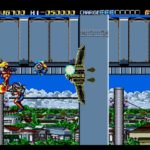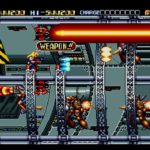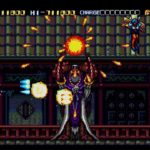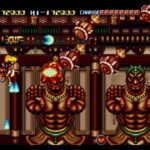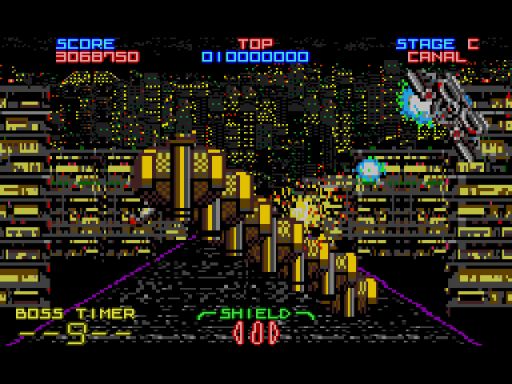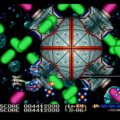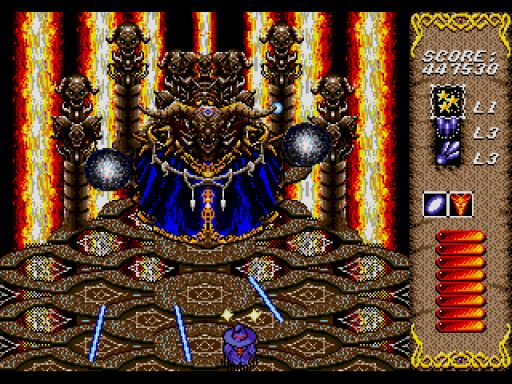Developer: Vik Tokai Publisher: Vik Tokai Released: December 24, 1993 Genre: Shooter Platform: Megadrive
I love finding hidden gems in a system’s library. There is nothing quite like discovering a game that flew under the radar that turns out to be better than many highly publicized titles. Trouble Shooter was one of those games. Even within the Sega Genesis shooter library it was unique and is still insanely fun today. Unfortunately the dark side of this is that such titles usually don’t get sequels. In this case it did but the West would never see it. Battle Mania Daiginjou is one of the best shooters for the system and might even be in my personal top 10 of all time.
Mechanically Battle Mania Daiginjou isn’t that different from its predecessor. Outside of its first level you still control both Mania and Maria simultaneously. There are a few new control options that radically change how you play however. One side is exactly like the previous game. 2-sided is the opposite; rather than switching Maria’s direction you instead change Mania. It is kind of redundant to be honest as it is usually more prudent to have Maria back you up, not the other way around. 8-way is extremely cool. You have free range to fire in eight directions and can lock your fire when need be. It eliminates the need to reposition yourself all the time but comes with the caveat that you need to constantly lock your fire. But it is worth it. These options do a great job of making the game more accessible overall.
Battle Mania Daiginjou makes an incredibly strong impression from the start. Its initial mission sees Mania fly off alone to deal with the resurrection of Morgstein. This vertical ascent is extremely well done and the game does not let up from there. Surprisingly half the game takes place inside a giant train with an entire Japanese temple on its back! Yet the game has more variety than most games put together. Although the story is minimal it provides a logical progression from one level to the next. As you rocket down the city streets destroying the demon train eventually you’ll go inside it. From there you enter the temple on its back in a vertical ascent to the final battle. Daiginjou is longer than its predecessor at nine levels yet I still wanted more. That is the mark of a good game.
Despites its length Battle Mania Daiginjou has excellent pacing. Every level has a unique set of enemies and traps to deal with and is the appropriate length. Because of the varied settings the game can’t really afford to repeat itself and benefits from it. Daiginjou switches between vertical and horizontal and never loses a step. The set pieces are always extravagant no matter the viewpoint. Descending into the Kikokukyou base is incredibly thrilling as you try your best to avoid being crushed or flying into an unforeseen hazard. Even exploring the inside of the Demon Train proves fun as your visibility is limited due to its interior. Thanks to the different control options your experience will differ wildly but is no less efficient. That they were able to balance all three options so well speaks to the game’s quality.
In terms of difficulty Battle Mania Daiginjou falls in line with its prequel. Mania can still only take one hit before death but the game provides a decent amount of life restoring hearts. Those lives go fast as Mania is a large target, making bullet dodging hard. It is easy to forget that only Mania takes damage and lose track of her but that is part of the game. Special weapons play a big role in helping you deal with the chaos as they recharge pretty fast. Choosing the right one doesn’t necessary make a level trivial but it does help. The multi-phase boss battles are a real treat even if they become ridiculous after a point. I can’t begin to describe how much fun I had with Battle Mania; it is refreshing to play a shooter that is balanced rather than determinedly trying to kick your ass.
Although it was released in 1993 Daiginjou has the look of a late era Genesis title. This is a significant step up from the previous game. The game does not feature any extravagant special effects outside of the rolling tube of stage six. But that is because it doesn’t need it. The art direction is fantastic; both dark and comical at the same time. The variety in set pieces is off the charts and easy to overlook. There is up to six layers of scrolling at any given moment and it is always jaw dropping. The game also never slows down. Combined with the beyond awesome soundtrack and you have one incredibly tight game that is the full package.
In Closing
I can’t sing the game’s praises enough. Battle Mania Daiginjou is one of the best overall Genesis games in my opinion. It is a crime we missed this gem. Sadly it remains import only so play it however you can; you won’t regret it.


